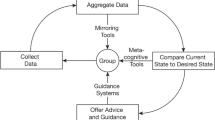Abstract
Technology-based assessments that involve collaboration among students offer many sources of process data, although it remains unclear which aspects of these data are most meaningful for making inferences about students’ collaborative skills. Recent research has focused mainly on theory-based rubrics for qualitative coding of process data (e.g., text from chat dialogues, click-stream data), but many reliability and validity issues arise in the application of such rubrics. In this research, we take a more data-driven approach to the problem. Data were collected from 122 dyads who interacted over online chat to complete a twelfth-grade mathematics assessment. We focus on features of chat and click-stream that can be extracted automatically, including the extent to which chat dialogue contained content from assessment materials; chat-based cues of affective tone and mirroring; and temporal synchronization in task-related activities. Using a block-wise linear regression, we show that process features of chat and click-stream accounted for 30.5% of the variation in group performance, after controlling for group members math proficiency and the total number of words in the chat dialogue. The full model explained 61% of the variation in group performance. Implications for the design and scoring of collaborative assessments are discussed.


Similar content being viewed by others
References
Adams, R., Vista, A., Scoular, C., Awwal, N., Griffin, P., & Care, E. (2015). Automatic coding procedures for collaborative problem solving. In P. Griffin & E. Care (Eds.), Assessment and teaching of 21st century Skills (pp. 115–132). Dordrecht: Springer. https://doi.org/10.1007/978-94-017-9395-7_6.
Attali, Y., & Burstein, J. (2004). Automated essay scoring with e-rater® V.2.0. ETS research report series, 2004(2), i–21. https://doi.org/10.1002/j.2333-8504.2004.tb01972.x.
Bergner, Y. (2018). CPSX: A tool for online collaborative problem-solving in open edX (Research memorandum no. RM-18-03). Technical report. Princeton, NJ: Educational Testing Service.
Bollen, K. A., & Jackman, R. W. (1985). Regression diagnostics: An expository treatment of outliers and influential cases. Sociological Methods & Research, 13(4), 510–542.
Bradley, M. M., & Lang, P. J. (1999). Affective norms for english words (anew): Instruction manual and affective ratings, Technical report. Citeseer.
Carlson, J. E., & von Davier, M. (2013). Item response theory (ETS research report series no. RR-13-28). Princeton, NJ: Educational Testing Service.
Chen, J., Wang, M., Kirschner, P. A., & Tsai, C.-C. (2018). The role of collaboration, computer use, learning environments, and supporting strategies in CSCL: A meta-analysis. Review of Educational Research,. https://doi.org/10.3102/0034654318791584.
Cleveland, W. S. (1993). Visualizing data. Murray Hill, N.J.; Summit, N. J. At & T Bell Laboratories; Published by Hobart Press. (OCLC: 607634013)
Crossley, S., Liu, R., & McNamara, D. (2017). Predicting math performance using natural language processing tools. In Proceedings of the seventh international learning analytics & knowledge (pp. 339–347).
Davis, J. H. (1973). Group decision and social interaction: A theory of social decision schemes. Psychological Review, 80(3), 97–125. https://doi.org/10.1037/h0021465.
Fiore, S. M., Graesser, A., Greiff, S., Griffin, P., Gong, B., Kyllonen, P., et al. (2017). Collaborative problem solving: Considerations for the national assessment of educational progress. Alexandria: National Center for Education Statistics.
Griffin, P., & Care, E. (2015). Assessment and teaching of 21st century skills: Methods and approach. New York, NY: Springer. https://doi.org/10.1007/978-94-007-2324-5.
Griffin, P., McGaw, B., & Care, E. (2012). Assessment and teaching of 21st century skills. New York: Springer.
Halpin, P. F., & Bergner, Y. (2018). Psychometric models of small group collaborations. Psychometrika,. https://doi.org/10.1007/s11336-018-9631-z.
Hao, J., Chen, L., Flor, M., Liu, L., & von Davier, A. A. (2017). CPS-rater: Automated sequential annotation for conversations in collaborative problem-solving activities: CPS-rater. ETS research report series, 2017 (No. 1, pp. 1–9). https://doi.org/10.1002/ets2.12184.
Hlavac, M. (2013). Stargazer: Latex code and ASCII text for well-formatted regression and summary statistics tables. http://CRAN.R-project.org/package=stargazer. Accessed 11 Nov 2018.
Ilgen, D. R., Hollenbeck, J. R., Johnson, M., & Jundt, D. (2005). Teams in organizations: From input-process-output models to IMOI models. Annual Review of Psychology, 56(1), 517–543. https://doi.org/10.1146/annurev.psych.56.091103.070250.
Jenkins, J. R., Fuchs, L. S., Van Den Broek, P., Espin, C., & Deno, S. L. (2003). Sources of individual differences in reading comprehension and reading fluency. Journal of Educational Psychology, 95(4), 719.
Johnson, D. W., & Johnson, R. T. (2009). An educational psychology success story: Social interdependence theory and cooperative learning. Educational Researcher, 38(5), 365–379. https://doi.org/10.3102/0013189X09339057.
Kerr, N. L., & Tindale, R. S. (2004). Group performance and decision making. Annual Review of Psychology, 55(1), 623–655. https://doi.org/10.1146/annurev.psych.55.090902.142009.
Kortemeyer, G. (2006). An analysis of asynchronous online homework discussions in introductory physics courses. American Journal of Physics, 74(6), 526. https://doi.org/10.1119/1.2186684.
Kozlowski, S. W. J. (2015). Advancing research on team process dynamics. Organizational Psychology Review, 5(4), 270–299. https://doi.org/10.1177/2041386614533586.
Kozlowski, S. W. J., & Ilgen, D. R. (2006). Enhancing the efectiveness of work groups and teams. Psychological Science in the Public Interest, Supplement, 73, 77–124. https://doi.org/10.1111/j.1529-1006.2006.00030.x.
Larson, J. R. (2010). In search of synergy in small group performance. New York, NY: Taylor & Francis Group.
Lee, Y.-H., & Jia, Y. (2014). Using response time to investigate students’ test-taking behaviors in a naep computer-based study. Large-Scale Assessments in Education, 2(1), 8.
Liu, L., Hao, J., von Davier, A. A., Kyllonen, P., & Zapata-Rivera, D. (2015). A tough nut to crack: Measuring collaborative problem solving. In Y. Rosen, S. Ferrara, & M. Mosharraf (Eds.), Handbook of research on computational tools for real-world skill development (pp. 344–359). Hershey, PA: IGI-Global. https://doi.org/10.1136/bmj.330.7485.0-h.
Marks, M., Mathieu, J. E., & Zaccaro, S. J. (2001). A conceptual framework and taxonomy of team processes. Academy of Management Journal, 26(3), 356–376.
Mathieu, J. E., Tannenbaum, S. I., Donsbach, J. S., & Alliger, G. M. (2014). A review and integration of team composition models: Moving toward a dynamic and temporal framework. Journal of Management,. https://doi.org/10.1177/0149206313503014.
OECD. (2017). PISA 2015 results (volume V): Collaborative problem solving. Paris: PISA, OECD Publishing. https://doi.org/10.1787/9789264285521-en.
Ogan, A., Finkelstein, S., Walker, E., Carlson, R., & Cassell, J. (2012). Rudeness and rapport: Insults and learning gains in peer tutoring. In: Lecture notes in computer science (including subseries lecture notes in artificial intelligence and lecture notes in bioinformatics) LNCS (Vol. 7315, pp. 11–21). https://doi.org/10.1007/978-3-642-30950-2_2.
Osgood, C. E., Suci, G. J., & Tannenbaum, P. H. (1969). The measurement of meaning. Chicago: Aldine Publishing Company.
Pentland, A. (2010). To signal is human: Real-time data mining unmasks the power of imitation, kith and charisma in our face-to-face social networks. American Scientist, 98(3), 204–211.
R Core Team. (2019). R: A language and environment for statistical computing. R foundation for statistical computing, Vienna, Austria. https://www.R-project.org/.
Thurstone, L. L. (1937). Ability, motivation, and speed. Psychometrika, 2(4), 249–254.
van der Linden, W. J. (2009). Conceptual issues in response-time modeling. Journal of Educational Measurement, 46(3), 247–272.
Webb, N. M. (1995). Group collaboration in assessment: Multiple objectives, processes, and outcomes. Educational Evaluation and Policy Analysis, 17(2), 239–261. https://doi.org/10.3102/01623737017002239.
Wise, A. F., & Cui, Y. (2018). Unpacking the relationship between discussion forum participation and learning in MOOCs. In Proceedings of the 8th international conference on learning analytics and knowledge—LAK ’18 (pp. 330–339). https://doi.org/10.1145/3170358.3170403.
Author information
Authors and Affiliations
Corresponding author
Additional information
Publisher's Note
Springer Nature remains neutral with regard to jurisdictional claims in published maps and institutional affiliations.
Appendices
Appendix 1
This “Appendix” derives the group performance measure \(\varDelta\) presented in Sect. 2.2.1 from the SC-IRT model developed by Halpin and Bergner (2018). The SC-IRT model describes the probability of both members of a dyad providing a correct response to a collaborative-solved item, denoted \(R_i\), for \(i = 1, \dots , I\). The group probability is modeled as a function of the probability of either partner solving the item when working individually, \(P_{ij}\), for \(j = 1, 2\). The model additionally includes a decision parameter, w, that describes how the individual probabilities combine to produce the group result. The model can be written:
To obtain the scoring rule used in the present analysis, we first sum both sides of the equation to obtain the model-implied total scores, and then re-arrange to solve for w:
Eq. 1 of the paper is obtained by replacing the model-implied total scores with the observed total scores on the mean-equated individual and collaborative test forms. Finally, we divided the numerator and denominator by I to change the total scores to proportion correct. For further details on the theoretical motivation and properties of the SC-IRT model, please see Halpin and Bergner (2018).
Appendix 2
See Table 5.
Rights and permissions
About this article
Cite this article
Mohan, K., Bergner, Y. & Halpin, P. Predicting Group Performance Using Process Data in a Collaborative Assessment. Tech Know Learn 25, 367–388 (2020). https://doi.org/10.1007/s10758-020-09439-5
Published:
Issue Date:
DOI: https://doi.org/10.1007/s10758-020-09439-5




